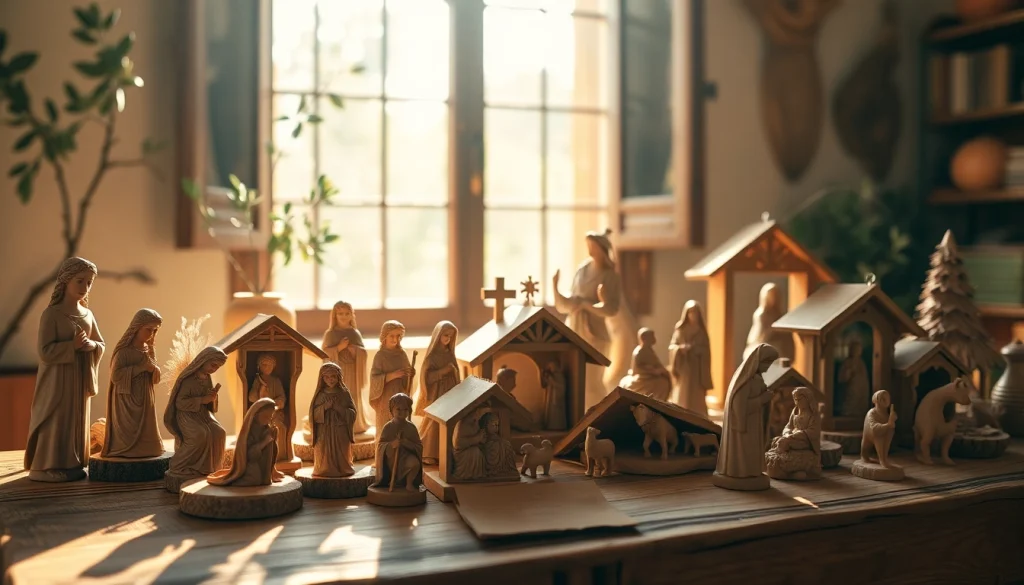Exquisite Olive Wood Carvings: Craftsmanship from the Holy Land

Understanding Olive Wood Carvings
Olive wood carvings are exquisite pieces of art that embody a rich tradition of craftsmanship originating from the Holy Land. These unique artifacts are not only visually stunning but also hold significant cultural and religious meaning. Skilled artisans, primarily from Bethlehem and Jerusalem, create beautiful representations of biblical scenes, figures, and decorative items from the wood of olive trees that have stood the test of time. In this article, we will explore the intricacies of olive wood carvings, including their historical significance, the talented artisans behind the craft, and the various types of carvings available.
What Are Olive Wood Carvings?
Olive wood carvings refer to sculptures, religious items, and decorative pieces crafted from the wood of olive trees. Known for its beautiful grain patterns and durability, olive wood is a preferred material among artisans. The carvings often depict biblical figures, nativity scenes, crosses, and a variety of household decorations, making them highly sought after as personal treasures or gifts. Olive wood carvings stand out not only for their aesthetic appeal but also for the stories they tell and the craftsmanship they embody.
Historical Significance of Olive Wood Art
Olive wood carving dates back centuries and has its roots in the ancient civilizations of the Mediterranean region. Olive trees are deeply intertwined with the culture and history of the Holy Land; they are symbols of peace and longevity. The craft of carving olive wood has been passed down through generations, often from father to son, preserving techniques and traditions that reflect both local culture and religious faith. The art form not only serves as a source of income for many families but also keeps alive the stories and traditions of the region.
Artisans Behind the Craft
The artisans who create olive wood carvings are often members of local Christian communities, particularly those in Bethlehem and Jerusalem. These craftsmen combine artistic skill with cultural heritage, pouring their creativity into each piece. Many artisans are trained from a young age, learning the nuances of working with olive wood through apprenticeships. Each carving reflects the artist’s personal style and devotion to the craft, making every piece unique. Additionally, the artisans’ dedication ensures that the items are not only high quality but also uphold the traditions of their communities.
Types of Olive Wood Carvings
Common Figurines and Statues
Among the most popular items in the olive wood carving category are figurines and statues that depict various characters from the Bible. These can range from simple representations of angels and saints to intricate figures of the Holy Family. Artisans skillfully carve each piece, paying close attention to detail to capture the essence of the figures. Statues of Mary, Joseph, and Christ are particularly cherished by collectors and those seeking to enhance their spiritual sanctuaries.
Unique Nativity Scenes
Olive wood nativity scenes are a hallmark of the craft, especially during the Christmas season. These elaborate displays often feature not only the Holy Family but also a host of other characters, including animals and angels, set against beautifully carved backdrops. Each piece is carefully crafted to capture the warmth and miracle of Christ’s birth. Due to their intricate detail and cultural significance, nativity sets made from olive wood are seen as treasured gifts, passed down through generations.
Decorative Items for Home
Besides religious figurines, artisans create a plethora of decorative items that serve both functional and aesthetic purposes in the home. These include bowls, crosses, candle holders, and coasters. The rich hues of olive wood, combined with its distinctive grain patterns, make these decorative pieces an attractive addition to any setting. Many individuals appreciate olive wood for its durability and its ability to withstand the test of time, making it a wise investment for both decoration and functionality.
How Olive Wood Carvings Are Made
Harvesting Olive Trees
The journey of an olive wood carving begins with the harvesting of olive trees. Unlike many woods, olive trees are not cut down but pruned. This sustains the health of the tree and ensures the continuity of the wood supply. Artisans typically gather wood from trees that are several decades old, as this wood has a dense grain and is more durable. The pruning process is done with great care, respecting both the artistry and nature, ensuring that future generations will also have access to this precious resource.
Carving Techniques and Tools
Carving olive wood requires specialized tools and techniques, developed over centuries. Craftsmen use chisels, knives, and gouges to shape the wood into desired forms. The process often begins with a rough outline, gradually refining details as the piece progresses. Artisans must possess a high level of skill and patience, as olive wood can be challenging to work with due to its density. Additionally, many artisans combine traditional hand-carving methods with modern tools to achieve accuracy and precision, resulting in pieces that perfectly blend heritage and contemporary artistry.
Finishing Touches and Preservation
Once the carving is complete, each piece undergoes a finishing process that enhances its natural beauty. This usually involves sanding and applying a protective finish, such as oil or beeswax, to highlight the wood’s grain and color. Proper finishing not only beautifies the carving but also ensures its longevity. Artisans emphasize the importance of preservation techniques, guiding buyers on how to care for their items to maintain their beauty over time. Regular dusting and occasional oil treatment can keep olive wood carvings looking fresh and vibrant.
Where to Buy Authentic Olive Wood Carvings
Top Online Retailers
For those interested in purchasing olive wood carvings, a variety of online retailers provide a wide selection of high-quality items. Many retailers source their products directly from artisans in the Holy Land, ensuring authenticity. Some reputable online stores include Holy Land Gift Shop, Bethlehem Handicrafts, and My Jerusalem Store. Each of these retailers offers unique handcrafted items that reflect the rich tradition of olive wood carving while supporting local artisans.
Local Artisans and Markets
For a more immersive experience, visiting local markets and artisan workshops in Bethlehem and Jerusalem allows buyers to engage directly with craftsmen. Purchasing directly supports communities and provides an opportunity to learn about the art and story behind each piece. Travelers to the Holy Land often find themselves enchanted by the variety of items available, as well as the chance to interact with artisans who can share their expertise.
What to Look for When Purchasing
When buying olive wood carvings, authenticity and quality are key considerations. Look for signs of skillful craftsmanship, such as fine details and smooth finishes. Additionally, inquire about the source of the wood and the artisan’s background. Considering a piece’s uniqueness, such as variations in grain or design, can also enhance its value. Lastly, be wary of mass-produced items—supporting small artisans ensures that the craft of olive wood carving continues to thrive.
Benefits of Olive Wood Carvings
Artistic and Cultural Importance
Olive wood carvings resonate deeply with both artistic and cultural significance. They are tangible manifestations of the rich history and creativity of the artisans who create them. These pieces serve as a form of cultural expression, reflecting the identity and heritage of communities in the Holy Land. Moreover, they offer collectors and admirers a physical connection to a region known for its profound spiritual and historical narratives.
The Symbolism of Olive Wood
Olive wood holds a special place in many cultures and religions, symbolizing peace, hope, and endurance. In the context of Christianity, olive branches represent peace and reconciliation, making olive wood carvings particularly significant as gifts or personal symbols of faith. Each piece carries with it the weight of history, spirituality, and the artistry invested into its creation, making it a cherished item for many.
Eco-Friendly and Sustainable Choice
In an age where sustainability is crucial, olive wood carvings stand out as eco-friendly options. The process of harvesting wood from pruned trees contributes to the health of the olive groves and prolongs their lifespan. Furthermore, by purchasing handcrafted items, consumers support traditional craftsmanship over mass production, promoting environmental conservation and responsible sourcing. Collecting olive wood carvings can thus be an expression of personal values regarding sustainability and ethical consumerism.







